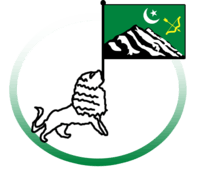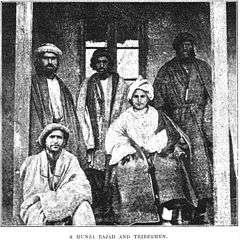Burusho people
|
A Hunza Rajah and Tribesmen in 19th century. | |
| Total population | |
|---|---|
| 87,000 (2000) | |
| Regions with significant populations | |
| Chitral District, Hunza, Pakistan | |
| Languages | |
| Burushaski, Khowar[1] | |
| Religion | |
| Ismaili Islam, Historically Shamanism[2] |

The Burusho or Brusho people live in the Hunza, Nagar and Chitral District, and valleys of Gilgit–Baltistan in northern Pakistan.[3] They are predominantly Muslims. Their language, Burushaski, has not been shown to be related to any other.[4]
Hunza


The Hunzakuts or Hunza people, are an ethnically Burusho people indigenous to the Hunza Valley, in the Karakorum Mountains of northern Pakistan. They are descended from inhabitants of the former principality of Hunza. A popular belief among some Burusho clans is that they are the descendants of the Macedonian soldiers who came to the region with Alexander the Great's army in the 4th century BC.
To date no comprehensive DNA research has been conducted on a sizable or for that matter over a heterogeneous populas factoring various subsets of tribes existing in the region for over a couple of millennia. No conclusive evidence has been made either connecting genetic or linguistic roots to any ethnic groups present within the immediate region. The historical area of Hunza, and present Northern areas of Pakistan has over the centuries seen mass migrations, conflicts and resettling of various tribes and ethnicities of which the Dardic Shina race is the most prominent in regional history. People of the region have for centuries recounted their historical traditions down from one generation to the next, In an effort to preserve their ancestry. There are four major yet genealogically diverse clans in the historic area of Hunza that trace their paterlineal ancestry to varying ethnics groups. The Khurukutz, local history links them to the communities now settled in the Pamir region of the Wakhan/afghan corridor. The Buroong are said to have migrated up from the Indus region of the subcontinent. Diramiting, and Barataling, trace their roots to the balkan/east European ethnic diaspora. In addition to the clan system, Burusho society is divided into classes, including the Thamo being the royals followed by the Wazir family governing the state; the Trangfa & Akabirting being the head men of each village; the Bare and Sis groups that were the combat fighters; the Baldakuyos that were teamsters and carriers for other groups; and the Bericho that were the musicians, Another offshoot of the Bericho have migrated to the present Indian held Kashmir. Together the Hunza people are predominantly Shia Muslims of the Nizari Ismaili tradition.
Hunzakuts and the Hunza region have relatively high literacy rates, compared to most other districts in Pakistan. Hunza is a major tourist attraction in Pakistan, and many domestic and foreign tourists travel to the region to enjoy the picturesque landscape and stunning mountains of the area. The district has many modern amenities and is quite advanced by Asian standards. Local legend states that Hunza may have been associated with the lost kingdom of Shangri-La. The people of Hunza are by some noted for their exceptionally long life expectancy,[7] others describe this as a longevity narrative and cite a life expectancy of 53 years for men and 52 for women although with a high standard deviation.[8]
Upper Hunza locally called Gojal, is inhabited by people whose ancestors moved up from proper Hunza in an effort to irrigate and defend the bordering lands with China and Afghanistan. They speak a dialect called Wakhi, which is influenced not only by Brushahski but also by Dari and tajiki due to the close proximity and contact with these mountain communities. The Shina-speaking people live in the southern part of Hunza. They have come from Chilas, Gilgit, and other Shina-speaking areas of Pakistan.
Theories of Greek heritage
Genetic evidence supports only 2% Greek genetic component among the Pashtun ethnic group of Pakistan and Afghanistan,[9] not the Burusho.[10]
Genetics
A variety of Y-DNA haplogroups are seen among certain random samples of people in Hunza. Most frequent among these are R1a1 and R2a, which probably originated in Central Asia during the Upper Paleolithic.[11][12] R2a, unlike its extremely rare parent R2, R1a1 and other clades of haplogroup R, is now virtually restricted to South Asia. Two other typically South Asian lineages, haplogroup H1 and haplogroup L3 (defined by SNP mutation M20) have also been observed from few samples.[13] [12]
Other Y-DNA haplogroups reaching considerable frequencies among the Burusho are haplogroup J2, associated with the spread of agriculture in, and from, the neolithic Near East,[11][12] and haplogroup C3, of Siberian origin and possibly representing the patrilineage of Genghis Khan. Also present at lower frequency are haplogroups O3, an East Eurasian lineage, and Q, P, F, and G.[12] DNA research groups the male ancestry of some of the Hunza inhabitants with speakers of Pamir languages and other mountain communities of various ethnicites, due primarily to the M124 marker (defining Y-DNA haplogroup R2a), which is present at high frequency in these populations.[14] However, they have also an East Asian genetic contribution, suggesting that at least some of their ancestry originates north of the Himalayas.[15]
Influence in the Western world
Healthy living advocate J. I. Rodale wrote a book called The Healthy Hunzas in 1955 that asserted that the Hunzas, noted for their longevity and many centenarians, were long-lived because of their consumption of healthy organic foods such as dried apricots and almonds, as well as their getting plenty of fresh air and exercise.[16] He often mentioned them in his Prevention magazine as exemplary of the benefits of leading a healthy lifestyle. Since the opening per se of the state of Hunza to Pakistan and rest of the world, the diet which almost exclusively consisted of organically grown fruits and vegetables, oils, and seasonings grown within the immediate localities is now dominated by extensive trade with neighboring China and Pakistan. Subsequently lot of processed modern and even GMO food products have reached this remote habitation.
Dr. John Clark stayed among the Hunza people for 20 months and in his book Hunza - Lost Kingdom of the Himalayas[17] writes: "I wish also to express my regrets to those travelers whose impressions have been contradicted by my experience. On my first trip through Hunza, I acquired almost all the misconceptions they did: The Healthy Hunzas, the Democratic Court, The Land Where There Are No Poor, and the rest—and only long-continued living in Hunza revealed the actual situations". Regarding the misconception about Hunza people's health, John Clark also writes that most of patients had malaria, dysentery, worms, trachoma, and other things easily diagnosed and quickly treated; in his first two trips he treated 5,684 patients.
Furthermore, Clark reports that Hunza do not measure their age solely by calendar (metaphorically speaking, as he also said there were no calendars), but also by personal estimation of wisdom, leading to notions of typical lifespans of 120 or greater.
The October 1953 issue of National Geographic had an article on the Hunza River Valley that inspired Carl Barks' story Tralla La.[18]
Renée Taylor wrote several books in the 1960s, treating the Hunza as a long-lived and peaceful people.[19]
See also
References
- ↑ "TAC Research The Burusho". Tribal Analysis Center. 30 June 2009.
- ↑ Archived 5 November 2012 at the Wayback Machine.
- ↑ "Jammu and Kashmir Burushaski : Language, Language Contact, and Change" (PDF). Repositories.lib.utexas.edu. Retrieved 2013-10-20.
- ↑ "Burushaski language". Encyclopædia Britannica online.
- ↑ "Hunza". Flags of the World. 7 June 2008. Retrieved 19 June 2010.
- ↑ "Flag Spot Hunza (Pre-independence Pakistan)". Flagspot.net.
- ↑ Wrench, Dr Guy T (1938). The Wheel of Health: A Study of the Hunza People and the Keys to Health. 2009 reprint. Review Press. ISBN 978-0-9802976-6-9. Retrieved 12 August 2010
- ↑ Tierney, John (29 September 1996). "The Optimists Are Right". The New York Times.
- ↑ Y-chromosomal evidence for a limited Greek contribution to the Pathan population of Pakistan, European Journal of Human Genetics (2007) 15; published online 18 October 2006
- ↑ Y-Chromosomal DNA Variation in Pakistan, American Journal of Human Genetics, 70:1107–1124, 2002, pg. 117
- 1 2 R. Spencer Wells et al., "The Eurasian Heartland: A continental perspective on Y-chromosome diversity," Proceedings of the National Academy of Sciences of the United States of America (28 August 2001).
- 1 2 3 4 Firasat, Sadaf; Khaliq, Shagufta; Mohyuddin, Aisha; Papaioannou, Myrto; Tyler-Smith, Chris; Underhill, Peter A; Ayub, Qasim (2006). "Y-chromosomal evidence for a limited Greek contribution to the Pathan population of Pakistan". European Journal of Human Genetics 15 (1): 121–6.
- ↑ Qamar Raheel et al. "Y-Chromosomal DNA Variation in Pakistan". American Journal of Human Genetics 70 (1107–1124): 2002.
- ↑ R. Spencer Wells et al., The Eurasian Heartland: A continental perspective on Y-chromosome diversity, Proceedings of the National Academy of Sciences of the United States of America
- ↑ Jun Z. Li et al., Worldwide human relationships inferred from genome wide patterns of variation - Science, Vol. 319. no. 586 (22 February 2008), pp. 1100 - 1104.
- ↑ Rodale, J. I. The Healthy Hunzas 1955
- ↑ Clark, John (1956). Hunza - Lost Kingdom of the Himalayas (PDF). New York: Funk & Wagnalls. OCLC 536892.
- ↑ The Carl Barks Library Volume 12, page 229
- ↑ Taylor, Renée (1964). Long Suppressed Hunza health secrets for long life and happiness. New York: Award Books.
External links
- Humans of Hunza
- Investigation of the Greek ancestry of northern Pakistani ethnic groups using Y chromosomal DNA variation
- Alexander’s ‘descendants’ boost Macedonian identity by Neil MacDonald
